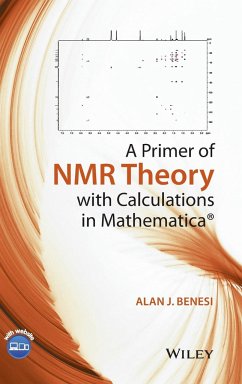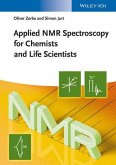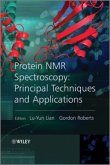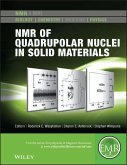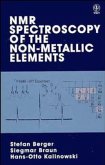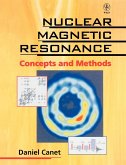Alan J. Benesi
A Primer of NMR Theory w/WS
Alan J. Benesi
A Primer of NMR Theory w/WS
- Gebundenes Buch
- Merkliste
- Auf die Merkliste
- Bewerten Bewerten
- Teilen
- Produkt teilen
- Produkterinnerung
- Produkterinnerung
Präsentiert die NMR-Theorie in Verbindung mit Unterlagen aus Mathematica-Kursen.
- Bietet kurze, Schwerpunktkapitel mit kurzen Erläuterungen zu definierten Themen und konzentriert sich dabei auf mathematische Beschreibungen. - Präsentiert prägnant wichtige Erkenntnisse aus der Quantenmechanik, die bei der Prognose und Simulation von Ergebnissen aus NMR-Versuchen einfach angewendet werden können. - Enthält Mathematica-Anleitungen, die die Theorie in Form von Text, Grafik, Ton und Berechnungsbeispielen praktisch umsetzen. - Geht auf bewährte Methoden des Autors aus über 25 Jahren…mehr
Andere Kunden interessierten sich auch für
![Applied NMR Spectroscopy for Chemists and Life Scientists Applied NMR Spectroscopy for Chemists and Life Scientists]() Oliver ZerbeApplied NMR Spectroscopy for Chemists and Life Scientists48,99 €
Oliver ZerbeApplied NMR Spectroscopy for Chemists and Life Scientists48,99 €![NMR Data Interpretation Explai NMR Data Interpretation Explai]() Neil E. JacobsenNMR Data Interpretation Explai146,99 €
Neil E. JacobsenNMR Data Interpretation Explai146,99 €![The Chemistry of Contrast Agents in Medical Magnetic Resonance Imaging The Chemistry of Contrast Agents in Medical Magnetic Resonance Imaging]() Andre S. MerbachThe Chemistry of Contrast Agents in Medical Magnetic Resonance Imaging173,99 €
Andre S. MerbachThe Chemistry of Contrast Agents in Medical Magnetic Resonance Imaging173,99 €![Protein NMR Spectroscopy Protein NMR Spectroscopy]() Protein NMR Spectroscopy111,99 €
Protein NMR Spectroscopy111,99 €![NMR of Quadrupolar Nuclei in Solid Materials NMR of Quadrupolar Nuclei in Solid Materials]() Roderick E WasylishenNMR of Quadrupolar Nuclei in Solid Materials155,99 €
Roderick E WasylishenNMR of Quadrupolar Nuclei in Solid Materials155,99 €![NMR Spectroscopy of the Non-Metallic Elements NMR Spectroscopy of the Non-Metallic Elements]() Stefan BergerNMR Spectroscopy of the Non-Metallic Elements1.025,99 €
Stefan BergerNMR Spectroscopy of the Non-Metallic Elements1.025,99 €![Nuclear Magnetic Resonance Nuclear Magnetic Resonance]() Daniel CanetNuclear Magnetic Resonance161,99 €
Daniel CanetNuclear Magnetic Resonance161,99 €-
-
-
Präsentiert die NMR-Theorie in Verbindung mit Unterlagen aus Mathematica-Kursen.
- Bietet kurze, Schwerpunktkapitel mit kurzen Erläuterungen zu definierten Themen und konzentriert sich dabei auf mathematische Beschreibungen.
- Präsentiert prägnant wichtige Erkenntnisse aus der Quantenmechanik, die bei der Prognose und Simulation von Ergebnissen aus NMR-Versuchen einfach angewendet werden können.
- Enthält Mathematica-Anleitungen, die die Theorie in Form von Text, Grafik, Ton und Berechnungsbeispielen praktisch umsetzen.
- Geht auf bewährte Methoden des Autors aus über 25 Jahren Lehrerfahrung zurück. Die Unterlagen erläutern präzise die Theorie und bieten nützliche Berechnungsvorlagen für NMR-Forscher.
Hinweis: Dieser Artikel kann nur an eine deutsche Lieferadresse ausgeliefert werden.
- Bietet kurze, Schwerpunktkapitel mit kurzen Erläuterungen zu definierten Themen und konzentriert sich dabei auf mathematische Beschreibungen.
- Präsentiert prägnant wichtige Erkenntnisse aus der Quantenmechanik, die bei der Prognose und Simulation von Ergebnissen aus NMR-Versuchen einfach angewendet werden können.
- Enthält Mathematica-Anleitungen, die die Theorie in Form von Text, Grafik, Ton und Berechnungsbeispielen praktisch umsetzen.
- Geht auf bewährte Methoden des Autors aus über 25 Jahren Lehrerfahrung zurück. Die Unterlagen erläutern präzise die Theorie und bieten nützliche Berechnungsvorlagen für NMR-Forscher.
Hinweis: Dieser Artikel kann nur an eine deutsche Lieferadresse ausgeliefert werden.
Produktdetails
- Produktdetails
- Verlag: Wiley & Sons / Wiley-Blackwell
- Artikelnr. des Verlages: 1W118588990
- 1. Auflage
- Seitenzahl: 250
- Erscheinungstermin: 5. Juni 2015
- Englisch
- Abmessung: 240mm x 161mm x 18mm
- Gewicht: 545g
- ISBN-13: 9781118588994
- ISBN-10: 1118588991
- Artikelnr.: 41565390
- Herstellerkennzeichnung
- Books on Demand GmbH
- In de Tarpen 42
- 22848 Norderstedt
- info@bod.de
- 040 53433511
- Verlag: Wiley & Sons / Wiley-Blackwell
- Artikelnr. des Verlages: 1W118588990
- 1. Auflage
- Seitenzahl: 250
- Erscheinungstermin: 5. Juni 2015
- Englisch
- Abmessung: 240mm x 161mm x 18mm
- Gewicht: 545g
- ISBN-13: 9781118588994
- ISBN-10: 1118588991
- Artikelnr.: 41565390
- Herstellerkennzeichnung
- Books on Demand GmbH
- In de Tarpen 42
- 22848 Norderstedt
- info@bod.de
- 040 53433511
Alan J. Benesi was Director of the Pennsylvania State University NMR Facility from 1987-2012. He earned his Ph.D. in Biophysics at the University of California, Berkeley, in 1975. He has published many papers related to solid state and liquid state NMR, solid state and liquid state NMR relaxation, and rotational and translational diffusion.
Preface viii Chapter 1 Introduction 1 Chapter 2 Using Mathematicac;
Homework Philosophy 3 Chapter 3 The NMR Spectrometer 4 Chapter 4 The NMR
Experiment 7 Chapter 5 Classical Magnets and Precession 11 Chapter 6 The
Bloch Equation in the Laboratory Reference Frame 16 Chapter 7 The Bloch
Equation in the Rotating Frame 19 Chapter 8 The Vector Model 23 Chapter 9
Fourier Transform of the NMR Signal 29 Chapter 10 Essentials of Quantum
Mechanics 31 Chapter 11 The Time ]Dependent Schrodinger Equation, Matrix
Representation of Nuclear Spin Angular Momentum Operators 35 Chapter 12 The
Density Operator 39 Chapter 13 The Liouville-von Neumann Equation 41
Chapter 14 The Density Operator at Thermal Equilibrium 42 Chapter 15
Hamiltonians of NMR: Isotropic Liquid ]State Hamiltonians 45 Chapter 16 The
Direct Product Matrix Representation of Coupling Hamiltonians HJ and HD 50
Chapter 17 Solving the Liouville-Von Neumann Equation for the Time
Dependence of the Density Matrix 54 Chapter 18 The Observable NMR Signal 59
Chapter 19 Commutation Relations of Spin Angular Momentum Operators 61
Chapter 20 The Product Operator Formalism 65 Chapter 21 NMR Pulse Sequences
and Phase Cycling 68 Chapter 22 Analysis of Liquid ]State NMR Pulse
Sequences with the Product Operator Formalism 72 Chapter 23 Analysis of the
Inept Pulse Sequence with Program Shortspin and Program Poma 78 Chapter 24
The Radio Frequency Hamiltonian 82 Chapter 25 Comparison of 1D and 2D NMR
86 Chapter 26 Analysis of the HSQC, HMQC, and DQF ]COSY 2D NMR Experiments
89 Chapter 27 Selection of Coherence Order Pathways with Phase Cycling 96
Chapter 28 Selection of Coherence Order Pathways with Pulsed Magnetic Field
Gradients 104 Chapter 29 Hamiltonians of NMR: Anisotropic Solid ]State
Internal Hamiltonians in Rigid Solids 111 Chapter 30 Rotations of Real
Space Axis Systems--Cartesian Method 120 Chapter 31 Wigner Rotations of
Irreducible Spherical Tensors 123 Chapter 32 Solid ]State NMR Real Space
Spherical Tensors 129 Chapter 33 Time ]Independent Perturbation Theory 134
Chapter 34 Average Hamiltonian Theory 141 Chapter 35 The Powder Average 144
Chapter 36 Overview of Molecular Motion and NMR 147 Chapter 37 Slow,
Intermediate, And Fast Exchange In Liquid ]State Nmr Spectra 150 Chapter 38
Exchange in Solid ]State NMR Spectra 154 Chapter 39 N MR Relaxation: What
is NMR Relaxation and what Causes it? 163 Chapter 40 Practical
Considerations for the Calculation of NMR Relaxation Rates 168 Chapter 41
The Master Equation for NMR Relaxation--Single Spin Species I 170 Chapter
42 Heteronuclear Dipolar and J Relaxation 183 Chapter 43 Calculation of
Autocorrelation Functions, Spectral Densities, and NMR Relaxation Times for
Jump Motions in Solids 189 Chapter 44 Calculation of Autocorrelation
Functions and Spectral Densities for Isotropic Rotational Diffusion 198
Chapter 45 Conclusion 202 Bibliography 203 INDEX 000
Homework Philosophy 3 Chapter 3 The NMR Spectrometer 4 Chapter 4 The NMR
Experiment 7 Chapter 5 Classical Magnets and Precession 11 Chapter 6 The
Bloch Equation in the Laboratory Reference Frame 16 Chapter 7 The Bloch
Equation in the Rotating Frame 19 Chapter 8 The Vector Model 23 Chapter 9
Fourier Transform of the NMR Signal 29 Chapter 10 Essentials of Quantum
Mechanics 31 Chapter 11 The Time ]Dependent Schrodinger Equation, Matrix
Representation of Nuclear Spin Angular Momentum Operators 35 Chapter 12 The
Density Operator 39 Chapter 13 The Liouville-von Neumann Equation 41
Chapter 14 The Density Operator at Thermal Equilibrium 42 Chapter 15
Hamiltonians of NMR: Isotropic Liquid ]State Hamiltonians 45 Chapter 16 The
Direct Product Matrix Representation of Coupling Hamiltonians HJ and HD 50
Chapter 17 Solving the Liouville-Von Neumann Equation for the Time
Dependence of the Density Matrix 54 Chapter 18 The Observable NMR Signal 59
Chapter 19 Commutation Relations of Spin Angular Momentum Operators 61
Chapter 20 The Product Operator Formalism 65 Chapter 21 NMR Pulse Sequences
and Phase Cycling 68 Chapter 22 Analysis of Liquid ]State NMR Pulse
Sequences with the Product Operator Formalism 72 Chapter 23 Analysis of the
Inept Pulse Sequence with Program Shortspin and Program Poma 78 Chapter 24
The Radio Frequency Hamiltonian 82 Chapter 25 Comparison of 1D and 2D NMR
86 Chapter 26 Analysis of the HSQC, HMQC, and DQF ]COSY 2D NMR Experiments
89 Chapter 27 Selection of Coherence Order Pathways with Phase Cycling 96
Chapter 28 Selection of Coherence Order Pathways with Pulsed Magnetic Field
Gradients 104 Chapter 29 Hamiltonians of NMR: Anisotropic Solid ]State
Internal Hamiltonians in Rigid Solids 111 Chapter 30 Rotations of Real
Space Axis Systems--Cartesian Method 120 Chapter 31 Wigner Rotations of
Irreducible Spherical Tensors 123 Chapter 32 Solid ]State NMR Real Space
Spherical Tensors 129 Chapter 33 Time ]Independent Perturbation Theory 134
Chapter 34 Average Hamiltonian Theory 141 Chapter 35 The Powder Average 144
Chapter 36 Overview of Molecular Motion and NMR 147 Chapter 37 Slow,
Intermediate, And Fast Exchange In Liquid ]State Nmr Spectra 150 Chapter 38
Exchange in Solid ]State NMR Spectra 154 Chapter 39 N MR Relaxation: What
is NMR Relaxation and what Causes it? 163 Chapter 40 Practical
Considerations for the Calculation of NMR Relaxation Rates 168 Chapter 41
The Master Equation for NMR Relaxation--Single Spin Species I 170 Chapter
42 Heteronuclear Dipolar and J Relaxation 183 Chapter 43 Calculation of
Autocorrelation Functions, Spectral Densities, and NMR Relaxation Times for
Jump Motions in Solids 189 Chapter 44 Calculation of Autocorrelation
Functions and Spectral Densities for Isotropic Rotational Diffusion 198
Chapter 45 Conclusion 202 Bibliography 203 INDEX 000
Preface viii Chapter 1 Introduction 1 Chapter 2 Using Mathematicac;
Homework Philosophy 3 Chapter 3 The NMR Spectrometer 4 Chapter 4 The NMR
Experiment 7 Chapter 5 Classical Magnets and Precession 11 Chapter 6 The
Bloch Equation in the Laboratory Reference Frame 16 Chapter 7 The Bloch
Equation in the Rotating Frame 19 Chapter 8 The Vector Model 23 Chapter 9
Fourier Transform of the NMR Signal 29 Chapter 10 Essentials of Quantum
Mechanics 31 Chapter 11 The Time ]Dependent Schrodinger Equation, Matrix
Representation of Nuclear Spin Angular Momentum Operators 35 Chapter 12 The
Density Operator 39 Chapter 13 The Liouville-von Neumann Equation 41
Chapter 14 The Density Operator at Thermal Equilibrium 42 Chapter 15
Hamiltonians of NMR: Isotropic Liquid ]State Hamiltonians 45 Chapter 16 The
Direct Product Matrix Representation of Coupling Hamiltonians HJ and HD 50
Chapter 17 Solving the Liouville-Von Neumann Equation for the Time
Dependence of the Density Matrix 54 Chapter 18 The Observable NMR Signal 59
Chapter 19 Commutation Relations of Spin Angular Momentum Operators 61
Chapter 20 The Product Operator Formalism 65 Chapter 21 NMR Pulse Sequences
and Phase Cycling 68 Chapter 22 Analysis of Liquid ]State NMR Pulse
Sequences with the Product Operator Formalism 72 Chapter 23 Analysis of the
Inept Pulse Sequence with Program Shortspin and Program Poma 78 Chapter 24
The Radio Frequency Hamiltonian 82 Chapter 25 Comparison of 1D and 2D NMR
86 Chapter 26 Analysis of the HSQC, HMQC, and DQF ]COSY 2D NMR Experiments
89 Chapter 27 Selection of Coherence Order Pathways with Phase Cycling 96
Chapter 28 Selection of Coherence Order Pathways with Pulsed Magnetic Field
Gradients 104 Chapter 29 Hamiltonians of NMR: Anisotropic Solid ]State
Internal Hamiltonians in Rigid Solids 111 Chapter 30 Rotations of Real
Space Axis Systems--Cartesian Method 120 Chapter 31 Wigner Rotations of
Irreducible Spherical Tensors 123 Chapter 32 Solid ]State NMR Real Space
Spherical Tensors 129 Chapter 33 Time ]Independent Perturbation Theory 134
Chapter 34 Average Hamiltonian Theory 141 Chapter 35 The Powder Average 144
Chapter 36 Overview of Molecular Motion and NMR 147 Chapter 37 Slow,
Intermediate, And Fast Exchange In Liquid ]State Nmr Spectra 150 Chapter 38
Exchange in Solid ]State NMR Spectra 154 Chapter 39 N MR Relaxation: What
is NMR Relaxation and what Causes it? 163 Chapter 40 Practical
Considerations for the Calculation of NMR Relaxation Rates 168 Chapter 41
The Master Equation for NMR Relaxation--Single Spin Species I 170 Chapter
42 Heteronuclear Dipolar and J Relaxation 183 Chapter 43 Calculation of
Autocorrelation Functions, Spectral Densities, and NMR Relaxation Times for
Jump Motions in Solids 189 Chapter 44 Calculation of Autocorrelation
Functions and Spectral Densities for Isotropic Rotational Diffusion 198
Chapter 45 Conclusion 202 Bibliography 203 INDEX 000
Homework Philosophy 3 Chapter 3 The NMR Spectrometer 4 Chapter 4 The NMR
Experiment 7 Chapter 5 Classical Magnets and Precession 11 Chapter 6 The
Bloch Equation in the Laboratory Reference Frame 16 Chapter 7 The Bloch
Equation in the Rotating Frame 19 Chapter 8 The Vector Model 23 Chapter 9
Fourier Transform of the NMR Signal 29 Chapter 10 Essentials of Quantum
Mechanics 31 Chapter 11 The Time ]Dependent Schrodinger Equation, Matrix
Representation of Nuclear Spin Angular Momentum Operators 35 Chapter 12 The
Density Operator 39 Chapter 13 The Liouville-von Neumann Equation 41
Chapter 14 The Density Operator at Thermal Equilibrium 42 Chapter 15
Hamiltonians of NMR: Isotropic Liquid ]State Hamiltonians 45 Chapter 16 The
Direct Product Matrix Representation of Coupling Hamiltonians HJ and HD 50
Chapter 17 Solving the Liouville-Von Neumann Equation for the Time
Dependence of the Density Matrix 54 Chapter 18 The Observable NMR Signal 59
Chapter 19 Commutation Relations of Spin Angular Momentum Operators 61
Chapter 20 The Product Operator Formalism 65 Chapter 21 NMR Pulse Sequences
and Phase Cycling 68 Chapter 22 Analysis of Liquid ]State NMR Pulse
Sequences with the Product Operator Formalism 72 Chapter 23 Analysis of the
Inept Pulse Sequence with Program Shortspin and Program Poma 78 Chapter 24
The Radio Frequency Hamiltonian 82 Chapter 25 Comparison of 1D and 2D NMR
86 Chapter 26 Analysis of the HSQC, HMQC, and DQF ]COSY 2D NMR Experiments
89 Chapter 27 Selection of Coherence Order Pathways with Phase Cycling 96
Chapter 28 Selection of Coherence Order Pathways with Pulsed Magnetic Field
Gradients 104 Chapter 29 Hamiltonians of NMR: Anisotropic Solid ]State
Internal Hamiltonians in Rigid Solids 111 Chapter 30 Rotations of Real
Space Axis Systems--Cartesian Method 120 Chapter 31 Wigner Rotations of
Irreducible Spherical Tensors 123 Chapter 32 Solid ]State NMR Real Space
Spherical Tensors 129 Chapter 33 Time ]Independent Perturbation Theory 134
Chapter 34 Average Hamiltonian Theory 141 Chapter 35 The Powder Average 144
Chapter 36 Overview of Molecular Motion and NMR 147 Chapter 37 Slow,
Intermediate, And Fast Exchange In Liquid ]State Nmr Spectra 150 Chapter 38
Exchange in Solid ]State NMR Spectra 154 Chapter 39 N MR Relaxation: What
is NMR Relaxation and what Causes it? 163 Chapter 40 Practical
Considerations for the Calculation of NMR Relaxation Rates 168 Chapter 41
The Master Equation for NMR Relaxation--Single Spin Species I 170 Chapter
42 Heteronuclear Dipolar and J Relaxation 183 Chapter 43 Calculation of
Autocorrelation Functions, Spectral Densities, and NMR Relaxation Times for
Jump Motions in Solids 189 Chapter 44 Calculation of Autocorrelation
Functions and Spectral Densities for Isotropic Rotational Diffusion 198
Chapter 45 Conclusion 202 Bibliography 203 INDEX 000

